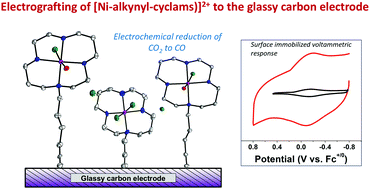当前位置:
X-MOL 学术
›
Chem. Commun.
›
论文详情
Our official English website, www.x-mol.net, welcomes your feedback! (Note: you will need to create a separate account there.)
Covalent attachment of [Ni(alkynyl-cyclam)]2+ catalysts to glassy carbon electrodes†
Chemical Communications ( IF 4.9 ) Pub Date : 2018-03-27 00:00:00 , DOI: 10.1039/c8cc00718g Almagul Zhanaidarova 1, 2, 3, 4, 5 , Curtis E. Moore 3, 4, 5, 6, 7 , Milan Gembicky 3, 4, 5, 6, 7 , Clifford P. Kubiak 1, 2, 3, 4, 5
Chemical Communications ( IF 4.9 ) Pub Date : 2018-03-27 00:00:00 , DOI: 10.1039/c8cc00718g Almagul Zhanaidarova 1, 2, 3, 4, 5 , Curtis E. Moore 3, 4, 5, 6, 7 , Milan Gembicky 3, 4, 5, 6, 7 , Clifford P. Kubiak 1, 2, 3, 4, 5
Affiliation

|
Surface modification of glassy carbon electrodes (GCEs) with molecular electrocatalysts is an important step towards developing more efficient heterogeneous CO2 reduction materials. Here, we report direct anodic electrografting of [Ni(alkynyl-cyclam)]2+ catalysts to the surface of GCEs in one simple step using inexpensive earth-abundant chemicals. When modified, these electrodes show reversible electrochemistry in organic solvents with zero peak-to-peak separations (ΔE = 0) and non-diffusive I (V) profiles that are typical for heterogeneous redox materials. CPE of these electrodes showed enhanced formation of H2 gas relative to CO compared to homogeneous catalysts.
中文翻译:

[Ni(炔基-环酰胺)] 2+催化剂与玻璃碳电极的共价结合†
用分子电催化剂对玻璃碳电极(GCE)进行表面改性是开发更有效的异质CO 2还原材料的重要步骤。在这里,我们报告了使用便宜的地球化学物质在一个简单的步骤中将[Ni(炔基-环酰胺)] 2+催化剂直接阳极电接枝到GCE的表面。修改后,这些电极在有机溶剂中显示出可逆的电化学性质,其峰峰间距为零(ΔE = 0),且非扩散性I(V)曲线对于异质氧化还原材料而言是典型的。与均相催化剂相比,这些电极的CPE显示出相对于CO增强了H 2气体的形成。
更新日期:2018-03-27
中文翻译:

[Ni(炔基-环酰胺)] 2+催化剂与玻璃碳电极的共价结合†
用分子电催化剂对玻璃碳电极(GCE)进行表面改性是开发更有效的异质CO 2还原材料的重要步骤。在这里,我们报告了使用便宜的地球化学物质在一个简单的步骤中将[Ni(炔基-环酰胺)] 2+催化剂直接阳极电接枝到GCE的表面。修改后,这些电极在有机溶剂中显示出可逆的电化学性质,其峰峰间距为零(ΔE = 0),且非扩散性I(V)曲线对于异质氧化还原材料而言是典型的。与均相催化剂相比,这些电极的CPE显示出相对于CO增强了H 2气体的形成。


























 京公网安备 11010802027423号
京公网安备 11010802027423号